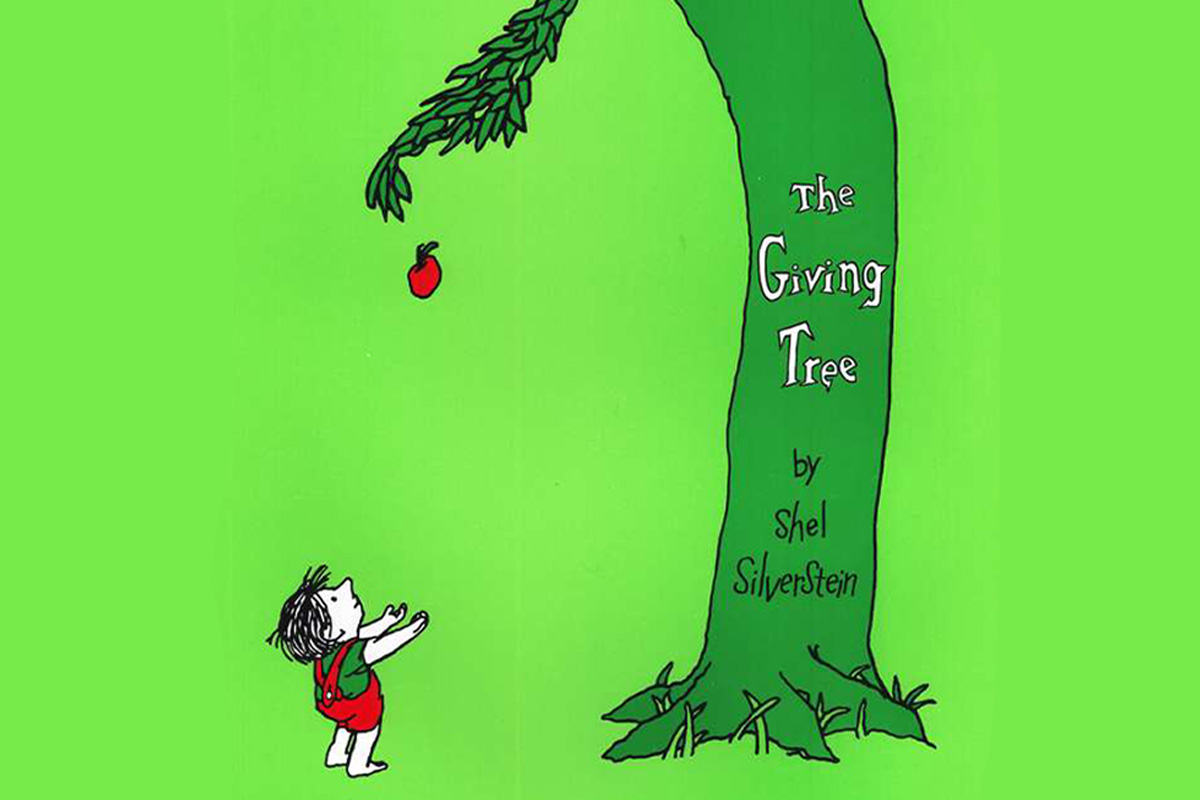I was 4 or 5 years old when I learned the sign language for “tree.” Rest your elbow on your opposite hand at a right angle. Spread your fingers and twist your hand a bit like leaves swaying in a breeze or a wave hello — a kind of palm tree. My Hebrew school music teacher was leading our class in the Etz Chaim hymn, sung as the Torah is returned to the ark: “Etz chaim hi lamaḥaziqim bah, v’tomkheha m’ushar / It is a tree of life for those who hold fast to it, and all its supporters are happy.” The song was a favorite of mine, both because I enjoyed the tune and the accompanying gestures, and because my dad’s name is Chaim, meaning “life.” I felt a connection.
I must have been the same age when I first read Jewish author-illustrator Shel Silverstein’s picture book “The Giving Tree” (1964) with my preschool class. It’s the tale of a tree and the boy she loves and provides for throughout his lifetime. She offers her leaves for shade, her trunk to climb, her branches to swing from, her apples to eat (and later sell for a profit), her wood for a house, and so on until all that’s left is a stump to sit on in his old age. The tree is described as happy, without an ounce of bitterness; she is giving and forgiving until the end.
I don’t really remember my early impressions of the story, other than a feeling of sadness, but I know it wasn’t a book that I returned to often. I preferred the laughs and literal monkey business of “Caps for Sale” by Esphyr Slobodkina, or the cozy companionship of Arnold Lobel’s “Frog and Toad” series. My mom, who worked for decades as an assistant preschool teacher at the local JCC where I attended pre-K, said “The Giving Tree” wasn’t her go-to choice for storytimes, because she found the end to be upsetting. “We read it aloud every year for Tu Bishvat,” she said, referring to the Jewish celebration of the trees. But that was it.
Yet, readers keep returning to Silverstein’s text and the evergreen themes it contains. The book’s many ripples of meaning extend outward like the rings of a tree, making for fruitful discussion and questioning — a key aspect of the Jewish tradition and, more broadly, a pedagogical tool for kindling young people’s curiosity. I’m more interested in the dialogue surrounding “The Giving Tree” — and how that dialogue has evolved since the book’s publication in 1964, and when I first read it in 1994 — than in the story itself.
“The Giving Tree” is a perennial bestseller, and a lasting source of debate among readers. In a 2012 blog post for School Library Journal, children’s librarian and author Betsy Bird called it “one of the most divisive books in children’s literature. To my mind, you are either a ‘Giving Tree’ fan or you loathe and abhor it.” Reactions are black-and-white, like Silverstein’s spare line drawings that illustrate the text:
It’s a heartwarming tribute to a mother’s unconditional love for her child.
It’s a cautionary tale about being grateful for what you have.
It’s an allegory about human exploitation of the environment.
It’s a disturbing model of a co-dependent relationship.
Tapping into criticism of the relationship at the center of the book, playwright Topher Payne recently wrote a humorous alternate ending in which the tree sets “healthy boundaries” and refuses the boy’s request to chop down her trunk for a house, instead encouraging him to practice empathy. The parody went viral, along with Payne’s other re-imaginings of beloved yet problematic children’s books.
Silverstein lampooned his own story in a 1979 cartoon for adults titled, “I Accept the Challenge,” featuring a nude woman who mutilates her male lover’s body until all that remains is his torso, which she sits on like a tree stump. Don’t tell the children!
No wonder “The Giving Tree” stirs up such conflicting responses. The story itself is rooted in binaries: nature vs. human; female vs. male; mother vs. son; giver vs. taker. The language is straightforward and declarative, following the structure of a fable. “Once there was a tree… and she loved a little boy,” the book begins. With every selfless act, we’re told, “the tree was happy.” The boy, however, can’t stop kvetching. No gift is enough; he always asks for more. Time and again the tree goes out on a limb for him, and not once does he return the favor or give thanks. Nor does he express remorse after destroying her.
Where’s the Jewish guilt?
Reading “The Giving Tree” now, I’m reminded of the archetypal Four Sons outlined in the Passover haggadah: the Wise, the Wicked, the Simple and the Son Who Doesn’t Know How to Ask. I’d propose a fifth son: the Chaza, Yiddish for “pig” or a greedy person. Silverstein’s boy doesn’t realize he should be grateful, for he has more than enough — dayenu.
Whether intentional or not on Silverstein’s part, there’s a bounty of Jewish symbolism to explore in “The Giving Tree.” As I learned all those years ago in Hebrew school, Etz Chaim/the Tree of Life is a metaphor for the Torah and its commandments. There’s also the Tree of Knowledge in the Garden of Eden, which bore the forbidden fruit that tempted Adam and Eve. These evocations are subtly yet intrinsically carved into the narrative, affirming my belief that it’s a quintessential Jewish book.
Even though Silverstein was Jewish, and we can read the Jewish values of tzedakah and chesed, or loving-kindness, in his work, “The Giving Tree” has also become popular in Christian circles. Children’s literature historian Leonard S. Marcus noted in his 2005 article for the New York Times Book Review that within a few years of the book’s publication, “sales of ‘The Giving Tree’ soared, spurred by word of mouth from, of all quarters, Protestant ministers and Sunday-school teachers, who embraced the book as a cogent restatement of the Christian ideal of unconditional love.” The precepts of self-denial and martyrdom, as embodied by the tree, do feel Christian in nature. And it strikes me that while the Jewish tradition promotes planting trees in Israel in honor of loved ones, every year millions are cut down and adorned for Christmas celebrations around the world commemorating the ultimate martyr.
Like a mighty family tree whose roots and branches span multiple epochs, Silverstein’s picture book endures as the story is handed down from generation to generation, l’dor v’dor. Even in this era of e-books and online streaming, the picture book is best enjoyed in printed form, allowing the reader to contemplate every detail while slowly turning the physical pages. It’s a tactile reminder of all that trees give us: paper and pencils for writing and drawing, shelves and books to fill them. The boy fails to give back to the earth, but we still have a chance to perform the mitzvah of planting seeds for the future, in hopes that they will germinate.
Late Take is a series on Alma where we revisit Jewish pop culture of the past for no reason, other than the fact that we can’t stop thinking about it?? If you have a pitch for this column, please e-mail submissions@heyalma.com with “Late Take” in the subject line.




